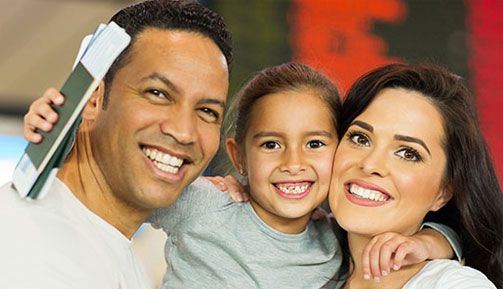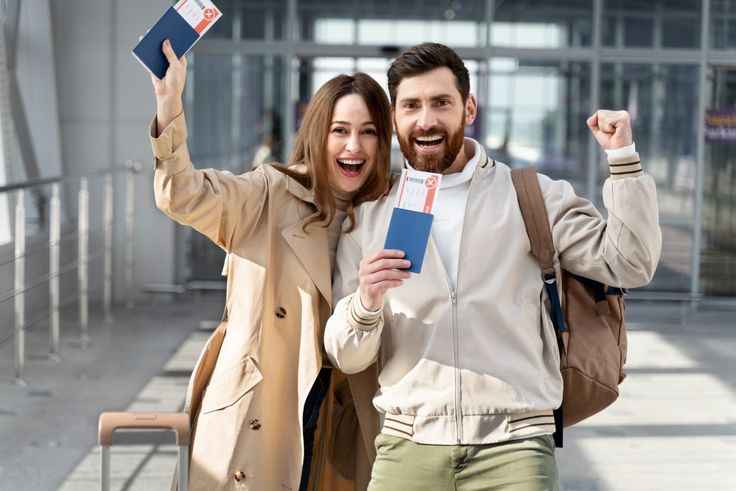Family-based visa sponsorship is one of the most popular pathways for individuals seeking to immigrate to the United States. This process allows U.S. citizens and lawful permanent residents (LPRs) to sponsor eligible family members for permanent residency (green card). In this guide, we’ll walk through the steps to successfully apply for a family-based visa sponsorship in the USA.
Overview of Family-Based Visa Sponsorship in the USA
Family-based visa sponsorship is one of the most effective ways to bring loved ones to the United States. The U.S. Citizenship and Immigration Services (USCIS) administers this program under two distinct categories, each catering to different types of familial relationships. This process not only facilitates family reunification but also plays a significant role in shaping the demographic and cultural fabric of the United States.
Categories of Family-Based Visa Sponsorship
1. Immediate Relatives of U.S. Citizens
This category is reserved for the closest family members of U.S. citizens. It offers a significant advantage: there are no annual caps on the number of visas issued under this category, ensuring quicker processing times. Eligible individuals include:
- Spouses of U.S. Citizens: This includes same-sex marriages, provided they are legally recognized.
- Unmarried Children Under 21 of U.S. Citizens: Biological, stepchildren, or adopted children qualify under specific conditions.
- Parents of U.S. Citizens: The sponsoring citizen must be at least 21 years old.
2. Family Preference Categories
Unlike immediate relatives, family preference visas are subject to annual numerical limits, often leading to longer waiting times. These are divided into four preference levels:
- F1 (First Preference): Unmarried children (21 years and older) of U.S. citizens.
- F2 (Second Preference): Spouses and unmarried children of lawful permanent residents (LPRs).
- F2A: Spouses and unmarried children under 21.
- F2B: Unmarried children 21 years or older.
- F3 (Third Preference): Married children of U.S. citizens.
- F4 (Fourth Preference): Siblings of U.S. citizens, provided the sponsor is at least 21 years old.
Key Steps in the Family-Based Visa Sponsorship Process
1. Filing the Petition (Form I-130)
The sponsorship journey begins with the U.S. citizen or LPR filing Form I-130, Petition for Alien Relative, to establish the familial relationship.
Essential Components of Form I-130
- Proof of Relationship: Birth certificates, marriage certificates, adoption documents, or affidavits confirming the relationship.
- Proof of Sponsor’s Status: A copy of the U.S. passport, naturalization certificate, or green card.
Pro Tip: Immediate relatives often benefit from expedited processing, while family preference categories may face longer delays due to visa quotas.
2. Meeting Eligibility Requirements
Both the sponsor and the beneficiary must meet certain criteria:
For the Sponsor
- Must be a U.S. citizen or LPR.
- Be at least 18 years old and residing in the U.S.
- Demonstrate financial ability to support the beneficiary by meeting income thresholds outlined in Form I-864 (Affidavit of Support).
For the Beneficiary
- Must belong to one of the eligible categories under U.S. immigration law.
- Provide evidence of good health, moral character, and financial independence.
3. National Visa Center (NVC) Processing
After USCIS approves Form I-130, the case moves to the National Visa Center (NVC) for further processing.
Key Steps at the NVC
- Pay processing fees and submit required documentation.
- Complete Form DS-260 (Immigrant Visa Application).
- Provide civil documents, such as police certificates, medical exam results, and financial evidence.
4. Consular Processing or Adjustment of Status
The next step depends on the beneficiary’s current location:
Consular Processing (Outside the U.S.)
- The beneficiary attends an immigrant visa interview at a U.S. embassy or consulate in their home country.
- Bring original documents, including passport, birth certificates, and proof of the relationship.
Adjustment of Status (Inside the U.S.)
- File Form I-485 (Application to Register Permanent Residence or Adjust Status) to become a green card holder.
- Attend a biometrics appointment and an in-person interview at a USCIS field office.
Pro Tip: If you’re considering marriage as a pathway to sponsorship, refer to “Can Marriage Help You Secure a Visa Sponsorship? Here’s What to Know” for detailed insights.
5. Receiving the Visa or Green Card
If the application is approved, the beneficiary will:
- Receive an immigrant visa to enter the U.S. if they underwent consular processing.
- Be issued a green card directly if they adjusted status while already in the U.S.
Benefits of Family-Based Visa Sponsorship
- Reunification of Loved Ones: Enables families to live together and build a life in the U.S.
- Path to Citizenship: Green card holders may eventually apply for U.S. citizenship through naturalization.
- Access to Opportunities: Beneficiaries gain access to the U.S. education system, job market, and healthcare services.
Challenges and How to Overcome Them
- Lengthy Processing Times: Family preference categories can experience backlogs. Regularly check the Visa Bulletin to stay updated.
- Insufficient Proof of Relationship: Collect robust evidence, including photographs, joint financial accounts, and affidavits.
- Financial Hurdles: Sponsors can seek joint sponsors to meet income requirements or use personal assets.
Broader Immigration Context
While family-based sponsorship is a popular route, other pathways like work and study visas also offer opportunities for individuals seeking to relocate to the U.S. or other countries:
- “Study in Canada: Fully Funded Visa Sponsorship Opportunities for Students“: Discover alternative education and immigration pathways.
Family-based visa sponsorship provides a structured and effective pathway to reunite loved ones in the United States. By understanding the categories, meeting eligibility requirements, and navigating the process with diligence, applicants can successfully secure permanent residency.
Whether you’re exploring family-based sponsorship or alternative immigration routes, staying informed and proactive is the key to success. For additional resources, check out our guides on scholarships, visa sponsorship jobs, and immigration pathways in other countries.
Step-by-Step Guide to Family-Based Visa Sponsorship: Filing Form I-130
Family-based visa sponsorship is a critical pathway for reuniting families in the United States. The process requires both the sponsor and the beneficiary to meet specific eligibility criteria and navigate the procedural steps with accuracy. This guide focuses on the initial steps: determining eligibility and filing Form I-130, Petition for Alien Relative.
Step 1: Determine Eligibility
Before initiating the sponsorship process, both the sponsor and the beneficiary must meet essential requirements to ensure the application’s validity and avoid delays.
Eligibility Requirements for the Sponsor
To file a family-based visa petition, the sponsor must:
- Be a U.S. Citizen or Lawful Permanent Resident (LPR): Proof of status, such as a U.S. passport, naturalization certificate, or green card, is required.
- Be at Least 18 Years Old: The sponsor must also reside in the U.S. to fulfill legal requirements for filing the petition.
- Demonstrate Financial Stability: The sponsor needs to meet income thresholds outlined in Form I-864 (Affidavit of Support) to prove their ability to financially support the beneficiary. Sponsors unable to meet the financial criteria may use a joint sponsor.
Pro Tip: If you’re exploring other pathways to U.S. residency, consider learning “How to Apply for a Fully Funded Scholarship in the USA” for education-based opportunities.
Eligibility Requirements for the Beneficiary
The beneficiary must also meet certain criteria, including:
- Belonging to an Eligible Category: Categories include immediate relatives (spouses, unmarried children under 21, or parents of U.S. citizens) and family preference categories (siblings, married children, and relatives of LPRs).
- Possessing a Valid Passport: The beneficiary must have a passport valid for international travel.
- Meeting Health and Character Standards: Medical examinations and background checks are typically required during later stages of the application.
Pro Tip: Beneficiaries planning to work in the U.S. can also explore options like “Visa Sponsorship Jobs in the UK: Industries Hiring Now“ for complementary career pathways.
Step 2: File Form I-130, Petition for Alien Relative
Filing Form I-130 is the cornerstone of family-based visa sponsorship. This petition establishes the familial relationship and initiates the visa application process.
Key Components of Form I-130
The form must be completed accurately and accompanied by supporting documents.
1. Proof of Relationship
Submit clear and verifiable evidence of your relationship with the beneficiary:
- Spouses: Marriage certificates, joint bank account statements, and wedding photos.
- Parents and Children: Birth certificates or adoption records.
- Siblings: Birth certificates showing shared parentage.
Pro Tip: For those applying as spouses, refer to “Can Marriage Help You Secure a Visa Sponsorship? Here’s What to Know” for guidance on presenting robust evidence.
2. Proof of Sponsor’s Status
Include documentation proving the sponsor’s legal status in the U.S.:
- A copy of their U.S. passport.
- Naturalization or citizenship certificate.
- Green card for lawful permanent residents.
3. Filing Fees
As of 2025, the filing fee for Form I-130 is $535. Check the USCIS website for the most up-to-date fee schedule.
Processing Times for Form I-130
Processing times for Form I-130 vary based on the category of the relationship:
Immediate Relatives of U.S. Citizens
Applications for immediate relatives, such as spouses, parents, and unmarried children under 21, are typically processed faster because they are not subject to annual visa caps.
Family Preference Categories
Applications under family preference categories (e.g., F1, F2A, F3, F4) may experience delays due to annual numerical limits. The waiting period can range from months to several years, depending on the beneficiary’s priority date and country of origin.
Pro Tip: Regularly monitor the Department of State’s Visa Bulletin to track visa availability for family preference categories.
Common Challenges When Filing Form I-130
- Incomplete Documentation: Missing or unclear evidence can lead to delays or denials. Double-check all supporting documents before submission.
- Financial Ineligibility: Sponsors who don’t meet the income threshold can consider using a joint sponsor or proving additional assets.
- Processing Delays: Backlogs can impact processing times, especially for family preference categories. Patience and consistent follow-ups are essential.
Pro Tip: For those waiting on family-based visas, explore career opportunities like “Top 10 Visa Sponsorship Jobs in Canada You Can Apply for Today“ to enhance your professional prospects in the interim.
Streamlining the Visa Process
If you’re considering additional immigration pathways or seeking funding for education, explore the following resources:
- “How to Apply for a Scholarship That Covers Both Tuition and Visa Costs“ for academic funding opportunities.
Filing Form I-130 is the first step in a family’s journey toward reunification in the United States. By understanding the process, meeting eligibility requirements, and preparing a complete application, you can navigate this pathway with confidence. For more insights into immigration, scholarships, or visa sponsorship opportunities, explore related guides tailored to your goals.
Step 3: Await the USCIS Decision
After submitting Form I-130, the U.S. Citizenship and Immigration Services (USCIS) begins the review process. This step involves detailed examination to verify the relationship between the sponsor and the beneficiary, as well as compliance with immigration laws.
Timeline for USCIS Review
The time it takes for USCIS to process Form I-130 varies significantly based on:
- Family-Based Category: Immediate relatives (e.g., spouses, unmarried children under 21, and parents of U.S. citizens) are typically processed faster than family preference categories, which are subject to annual numerical limits.
- USCIS Workload: Processing times fluctuate depending on the volume of applications.
How to Monitor Your Case
- Receipt Notice: Once USCIS receives your petition, you’ll receive Form I-797C, Notice of Action, containing your case number.
- Case Tracking: Use the USCIS case status online tool to track progress.
- Processing Time Updates: Check USCIS’s processing time estimates for the specific service center handling your case.
If Approved
If the petition is approved, USCIS will transfer your case to the National Visa Center (NVC) for the next steps.
Key Steps at the NVC
- Pay Required Fees: The NVC will notify you to pay the immigrant visa application fee and affidavit of support fee.
- Submit Supporting Documents: Upload financial evidence (Form I-864, Affidavit of Support), civil documents (e.g., birth and marriage certificates), and Form DS-260, the Immigrant Visa Application.
- Case Completion: Once all fees and documents are submitted, the NVC schedules the visa interview at the appropriate U.S. consulate or embassy.
Pro Tip: Explore options like “Top 15 Fully Funded Scholarships for International Students“ if you’re considering educational opportunities in addition to your immigration plans.
If Denied
Denial of Form I-130 can occur for various reasons, including insufficient evidence or ineligibility.
Options After Denial
- File an Appeal: If you believe the denial was in error, you can appeal to the Board of Immigration Appeals (BIA) using Form I-290B.
- Refile the Petition: If denial was due to missing documents or other rectifiable issues, you may correct the errors and submit a new petition.
Pro Tip: If pursuing an appeal or reapplication, consulting an immigration attorney can significantly improve your chances of success.
Step 4: Consular Processing or Adjustment of Status
Once USCIS approves the petition, the process diverges depending on whether the beneficiary resides inside or outside the United States.
For Beneficiaries Outside the U.S.: Consular Processing
Consular processing is the route for beneficiaries applying from abroad. The NVC transfers the case to the U.S. embassy or consulate in the beneficiary’s home country.
Steps in Consular Processing
- Complete Form DS-260: This is the online immigrant visa application. Provide details about your personal, travel, and immigration history.
- Attend the Visa Interview: Schedule and attend an interview at the consulate. During the interview, consular officers will review your case and documents, such as birth certificates, marriage certificates, and police clearance certificates.
- Medical Examination: Undergo a medical exam at an approved facility in your home country.
- Visa Issuance: If approved, the consulate issues an immigrant visa, allowing you to travel to the U.S. and receive your green card upon entry.
For Beneficiaries in the U.S.: Adjustment of Status (AOS)
Beneficiaries already in the U.S. may apply for a green card through adjustment of status. This process allows them to transition from their current visa to lawful permanent residency without leaving the U.S.
Steps for Adjustment of Status
- File Form I-485: Submit this form to USCIS to register for permanent residency.
- Biometrics Appointment: Attend an appointment where USCIS collects fingerprints, photographs, and a signature.
- Attend the Interview: USCIS may schedule an in-person interview to assess your eligibility. Bring all relevant documents, including proof of relationship and updated financial records.
- Approval and Green Card Issuance: Once approved, the applicant receives a green card, granting lawful permanent residency.
Pro Tip: If you’re in the U.S. on a temporary visa, explore “How to Secure a Visa Sponsorship Job in Canada“ as an additional pathway for securing long-term opportunities.
Key Considerations for Both Processes
Document Requirements
For both consular processing and adjustment of status, ensure all documents are complete, accurate, and up-to-date. Missing documents can result in delays or denials.
Timelines
While adjustment of status often allows beneficiaries to remain in the U.S. during processing, consular processing may take longer due to embassy backlogs and additional travel requirements.
Pro Tip: Applicants looking for other visa options can explore guides like “Step-by-Step Guide to Securing a Visa Sponsorship Job in Germany“ for insight into employment-based immigration.
By understanding the nuances of consular processing and adjustment of status, applicants can effectively navigate the family-based visa sponsorship process. Whether inside or outside the U.S., preparing thoroughly and adhering to USCIS guidelines can ensure a smoother journey toward reunification and lawful permanent residency.
Step 5: Affidavit of Support (Form I-864)
The sponsor must submit an affidavit of support to prove they can financially support the beneficiary. This document is legally binding and ensures the beneficiary will not rely on public assistance.
Income Requirements
Sponsors must meet or exceed 125% of the federal poverty guidelines. Alternative options, like joint sponsorship or using assets, are available for those who fall short.
Step 6: Attend the Interview
The interview is a crucial step where the beneficiary provides additional documentation and answers questions about their relationship with the sponsor.
Documents to Bring
- Passport
- Visa application confirmation
- Proof of the relationship (e.g., photos, communication logs)
Pro Tip
If applying as a spouse, see our guide “Can Marriage Help You Secure a Visa Sponsorship? Here’s What to Know“ for tips on presenting a convincing case during the interview.
Step 7: Receive the Visa or Green Card
If approved, the beneficiary receives an immigrant visa to enter the U.S. or a green card if already in the country.
Tips for a Successful Application
- Start Early: Processing times can be lengthy, especially for family preference categories.
- Be Thorough: Ensure all forms are complete and accurate to avoid delays.
- Seek Professional Guidance: Complex cases may benefit from legal advice or consulting immigration specialists.
Related Topics to Broaden Your Understanding
1. Visa Sponsorship for Work and Study Opportunities
If family sponsorship isn’t an option, explore visa sponsorship jobs or scholarships:
- “Top 5 Websites to Find Visa Sponsorship Jobs Anywhere in the World“ provides global job search platforms.
2. Pathways to Permanent Residency in Other Countries
While family-based sponsorship is a U.S.-focused pathway, other countries offer unique immigration options:
- “How to Secure Permanent Residency in Canada Through Marriage“ explores PR through spousal sponsorship.
Common Challenges and How to Overcome Them
- Delayed Processing: Regularly check your case status on the USCIS website.
- Insufficient Proof of Relationship: Gather extensive documentation, including photos, joint financial accounts, and affidavits from family or friends.
- Financial Constraints: Consider joint sponsorship or use assets to meet income requirements.
Conclusion
Applying for a family-based visa sponsorship in the USA is a detailed process, but with careful preparation and thorough documentation, it can lead to successful outcomes. This pathway not only reunites families but also offers beneficiaries the chance to build a stable life in the United States.
For those exploring alternative or complementary pathways, check out our guides on scholarships, visa sponsorship jobs, and residency opportunities in other countries. By staying informed and proactive, you can navigate the complexities of immigration with confidence.




